Signal or Noise: The August Reporting Season Special
A lot has happened since Signal or Noise last appeared on your screens in June. The US entered a technical recession, UK inflation hit 10%, China went into and came out of COVID-19 lockdowns, and the European Central Bank finally raised interest rates from a negative position. But markets are also forward-looking and fickle.
Economics is a tireless beast, pumping out data points all the time. Even Australian inflation will move to a partial-monthly release, bringing our CPI reporting process closer to those of our developed market peers.
On the other hand, indications of how these big picture headwinds affect (or do not affect) Australian corporates are less frequent. Perhaps this is why February and August reporting seasons are closely watched and nerve-wracking.
That's why we made this episode a reporting season special - deep diving into how macro changes the game for corporate earnings at a time when resilience is needed more than ever.
Joining me are:
- Diana Mousina, senior economist at AMP and regular panellist
- Kyle Macintyre, investment director at Firetrail Investments
- Matthew Haupt, lead portfolio manager at Wilson Asset Management for the WAM Leaders Fund.
What to expect
Every month, the team will analyse the biggest topics affecting your money in the world of economics and macro. In this episode, they are tackling the following subjects:
- Will an economic recession hit corporates hard?
- Does the collapse in global consumer confidence affect investment strategy?
- Why does the strength in the US Dollar matter so much?
Plus, our experts bring in their favourite charts to share with you! Listen in for the moment one of our guests changes their mind on the spot!
Hans Lee: Hello, and a warm welcome from all of us at Livewire Markets. To the latest episode of signal or noise, our series dedicated to making economics and data more accessible for your investments. I'm Hans Lee. Well, I'll tell you what. A lot has happened since we were last on the air a few weeks ago. We'll try and go through as much of it as we can in the next few minutes. But of course, markets are also forward-looking beasts. And right now, we are in the depths of the crunch time for all Australian investors, the August earnings season.
So without further ado, let us meet the team that we've assembled for this show. Kyle Macintyre, he's Investment Director at Firetrail Investments. Matthew Haupt, Lead Portfolio Manager of the Wilson Asset Management Leaders Fund, and Diana Mousina, of course, Senior Economist at AMP.
Topic 1: The "technical" recession
The U.S. recently entered a technical recession after recording a second consecutive quarter of negative economic growth. And of course, it's not just the U.S., with the UK probably not far behind, and indeed the rest of the eurozone due to the war in Ukraine. Now that's one thing in and of itself, but that's also probably where all the arguments start to begin.
And as we put up this chart on the screen for you, I'll take you through it because there are people who don't agree with that technical definition of a recession. So this chart here is from the team at MacroBond Financial, and it argues that there is every reason to believe that the world's largest economy is not in a recession. Now, part of their reason is that data goes through lots of revisions, which it does. But in other respects, if you look at the second half of that chart, you'll notice that the non-seasonally adjusted figure is not negative for two quarters yet. And some people prefer to use that definition over the definition that you see in the first half of that chart.
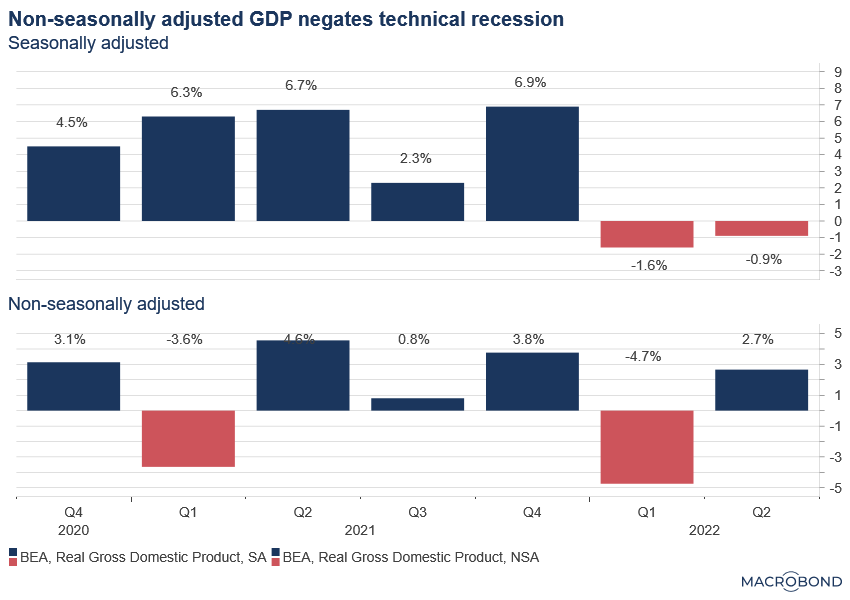
Hans Lee: Diana, that's a lot to unpack in the first little bit. My question I suppose to you is, I suppose, the possibility of an economic recession turning into an earnings recession, hidden corporate side. Do you see that as a big signal or as a lot of noise?
Diana Mousina: I think it is a signal. What I see is the NBER, the economic body in the U.S. classifies whether it is or isn't a recession, based on the indicators like payrolls, growth, employment, and income. They will meet in a few months' time. By that time, yes, maybe there will be a data revision that will show that the U.S. didn't go into a recession. But the second quarter fall was quite decent and we've never seen two negative consecutive quarters without it being a recession. So the problem is that maybe they'll start to call it a recession starting towards the end of the second quarter. Maybe the recession didn't start at the right beginning of the year. Maybe it started around the middle of the year. So I think it's a sign, potentially, of weakness to come in the U.S. economy and that's what I'm anticipating,
Hans Lee: Matt, what do you make of the recession debate? Is it a signal or a noise?
Matthew Haupt: I'm going to go with noise, mainly on Diana's point around, we'll have this debate and they'll classify the recession maybe in six, seven months' time from when it was actually happening. So in essence, it's noise because the market's forward-looking and we work the way through it. But corporate earnings are under pressure and they're going to be under pressure for the next six to nine months. But with stock prices, sometimes it's not even linked to earnings. You've got financial conditions as well, the backdrop of how supportive equities are. So sometimes you can have stock prices going up with earnings going down if financial conditions are easing. So there are a lot of moving parts at the moment. So I want to go with noise for the moment because I think equity markets are working their way through this argument already.
Hans Lee: So how does the discourse inform your investing thesis right now?
Matthew Haupt: We're looking at forward markets, bond markets. You look at the bond market. I mean, that's clear there are interest rate cuts priced in. Leading indicators are all rolling over heavily. Surveys are really, really poor, all the surveys. So I think the way we look at it is we are looking at other markets for a signal and bond markets for us are probably the best read on where we're going.
Hans Lee: Kyle, I'll put the same question to you. What do you make of it? Signal or noise?
Kyle Macintyre: I'm going to be controversial here and give you a bit of both. Right now, I think it's absolutely noise. And I think a lot of investing is considering expectations, which I think is what we were talking to earlier. And expectations coming into this August result were pretty dire. What you've seen is things aren't as bad as what people thought. Consumer discretionary is actually holding up quite well. When you look at the bank results, things aren't too bad and bad debts haven't yet spiked.
However, I do think it's a signal for what's to come. What I'd remind investors is that in Australia, the rate hike started in May. We're only a little bit of the way there and if you listen to the RBA, they say it takes one to two years for this sort of thing to take effect. And so whilst I think it's noise today, I think when you're thinking about positioning portfolios, we do believe we are going into an economic slowdown and so it's potentially a signal for things to come.
Hans Lee: Let me pose a quick question to all of you and Matt, Kyle, feel free to go into stock specifics, and Diana, feel free to stay at the big picture. What is the risk that we've talked ourselves into a recession, so much so, maybe, that our expectations have significantly depressed August earnings? I'm going to start with you, Kyle.
Kyle Macintyre: I think there is a real risk that corporates can talk themselves into a recession, and let me give you a live example. In the last couple of weeks, we did a research trip into the U.S. and we were talking with some of the largest casino operators in the regional areas of the U.S. It was really interesting to talk to one of them who said that they weren't investing any more in the slot machines on their floor. We asked them why that was. We asked them if what we were looking for was some sort of signal that there was a consumer slowdown. And so we said, "Are you seeing a consumer slowdown?" And the answer was, "No, we're not, but we expect it to come."
And so what you can actually see with corporates is you're seeing things like people stopping investing, you're seeing in the tech sector, people starting to lay staff off. And so you can actually have a self-fulfilling cycle. It really depends on how people are allocating capital.
Hans Lee: Matt, what do you think? Are expectations so low for this particular time?
Matthew Haupt: I think the expectations are justified. We're in an environment where you look at the major equations like people's income, consumption is the major part of an economy and the pressure on discretionary spending is rising. So someone's spending is someone's income. So I just think the mix is very negative for the next 12, 18 months. I think expectations are low and I think it's fair. I think it matched where we are going.
Hans Lee: Diana, what do you think?
Diana Mousina: You can always get periods where the survey data actually does not fit in with the real hard data. I mean, the Australian consumer sentiment figures are around recession-like levels, but the retail sales figures haven't slowed down significantly and some of the bank credit card data, which we get weekly, hasn't completely rolled over. It's slowed or plateaued a little bit, but it's not falling just yet. And there is obviously this lag with interest rates. I mean, I've only had one rate hike through on my own mortgage and the RBAs done 175 basis points. So there's a lot more to come and I think we'll start to see that towards the end of the year.
Topic 2: The collapse in global consumer sentiment
Hans Lee: All right, you were talking about casinos, you are talking about consumer discretionary [stocks]. Why don't we move to the consumer for our second topic? In this case, it is the collapse in global consumer sentiment. Now, here in Australia, we get two reads of consumer sentiment, generally. We get the weekly read from ANZ-Roy Morgan, and then we get the monthly read, which comes from the Westpac Melbourne Institute.
Weekly consumer sentiment, rather, is hanging around lows not really seen since April 2020. And of course, the sentiment problem is also pronounced right across the world, not just here in Australia, but in the UK, the U.S., and even China, where those COVID 19 lockdowns were hanging around for a while.
You can see that in this chart, which we're going to put up now. Now that chart that you can see on the screen is from Callum Thomas at Topdown Charts. I think it really goes to the heart of that. If you pan your attention to the far right of the screen, that's the part that's sort of most interest to us. Because if you see that aqua line, where we're talking about consumer confidence, the falls are so incredibly steep.
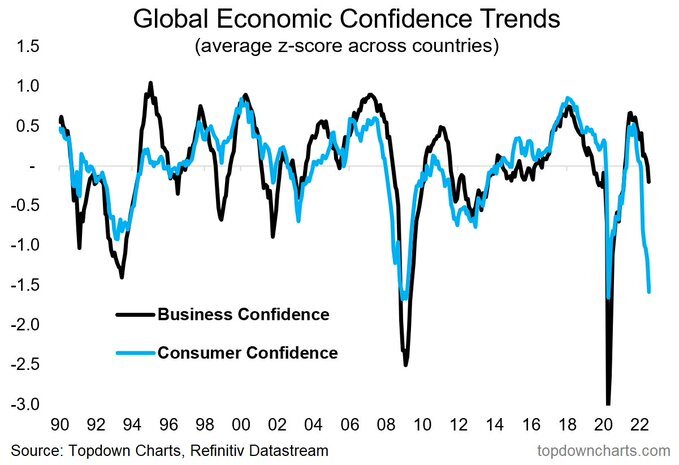
Hans Lee: So Matt, I'll go to you on this one. Does the collapse in consumer sentiment matter to you, does it matter to your investments and maybe your outlook, as well, for the August reporting season? Signal or noise?
Matthew Haupt: It's definitely a signal, but are we factoring in too much in the way of pessimism? At the moment, it feels like we are, but saying that I feel like we're on a journey there. I think sentiments probably move too hard, too fast, and we'll get a bit of a lift because even though the current surveys are actually printing better than expectations, the forward-looking surveys are actually worse. So I think we've just gone a little bit too hard, but I think we will eventually get there though.
Hans Lee: Kyle, I'll pose the same question. Signal or noise?
Kyle Macintyre: I do think it's signal and I agree with Matt's comment that we are comping some really big extremes if you consider how many people bought things through COVID and where things got. Even when you look at the trend line in terms of online penetration of total sales, you're seeing that start to revert back to the long-term mean. And so potentially, there's a bit of reversion going on where things were so good and now we're sort of getting back towards the base or normalised levels. But when I think about a signal, that's exactly what it is. It's a signal for you to do more work. When I dive into the consumer and you look at the different aspects, one area that does concern me is the discretionary good side, despite the fact that we do still have a lot of built-up savings here in Australia.
Kyle Macintyre: I also think you've got a lot of built-up, pent-up demand for services, for things like travelling, going around the world. And when you look at the credit card data, that is where you are seeing a lot of the incremental spending goes. Now it's swung away when people couldn't do anything and I think it's going to swing back. And it's interesting, that you mentioned Vegas before.
Vegas, right now, is still very strong because it's seen as a destination services style, but then you look at the regional areas and they're sort of thinking about a slowdown. So I think when you think about the consumer, you got to break it into goods and services. Potentially, services can be okay because of the pent-up demand there for an extended period of time, but I definitely think this consumer sentiment is a signal.
Hans Lee: Let me expand on that question then for you, Matt, as well, and for Kyle. What does that mean in terms of portfolio positioning? Are you completely out of the retailers?
Kyle Macintyre: I think you've got to be selective because you've really got to think about what's priced in. Sometimes some of the best investment opportunities are where expectations are really, really low and things turn out to be not as bad as what you thought because they're the times when you can pick up some really big bargains. We are being quite selective in that space. We do have some consumer exposure, more linked to the services side, particularly through something like Qantas Airways (ASX: QAN), but you've got to risk adjusting your position size based on the reality that things are looking like they're going to slow down.
Hans Lee: What about you, Matt?
Matthew Haupt: I look at the macro and think negative, but then you've got to find the micro opportunities within the sector. We sort of flex towards things that are more stable in that sector. We've got companies like Aristocrat Leisure (ASX: ALL), which gambling is discretionary, but it's got more stickiness versus other, buying clothes.
So we look for those companies which actually perform better through the cycle when going into a downturn. So I think macro is negative, but then you've got these individual micro opportunities, which we're still finding.
Hans Lee: For you, Diana, obviously consumer sentiment, we were discussing that with corporates, but it's also a massive problem for central banks. Do you think the worsening prints are a signal or noise?
Diana Mousina: I was going to say signal, but I'm going to change my mind. I'm going to say like you were saying before, I'll say noise in the short term because as we were talking about, I completely agree that there is going to be this delay. We'll only see the worst of it, especially here in Australia, I think, towards the end of this year or into early next year. I mean, we have to. I don't see how there's any other way that we don't avoid a pretty significant downturn and a significant weakening in growth where the hardest tightening cycle that the RBA has had since 1994.
Consumers are more leveraged than ever. Australia's housing market is much more vulnerable to rising variable rates as well because the majority of the loan book is variable. Whereas in countries like the U.S. and New Zealand, the majority of the loan book is actually fixed. So they don't feel the initial interest rate rises as much, but later down the track I think that the consumer sentiment figure is pointing to a signal, maybe in six to 12 months' time.
Topic 3: The strong US Dollar
Hans Lee: We'll get to our final topic. And I thought we'd take a look at the currency market. I know it's not always the most exciting topic of all time, but I specifically want to look at the strength of the U.S. dollar. Now while their central banks are tightening their policy around the world, the fact that the U.S. is the largest, it is the most influential of all the central banks means that the U.S. dollar is always going to take a lot of the focus. Now, if we put up this chart, this is the U.S. dollar index's performance over the last six months or so.
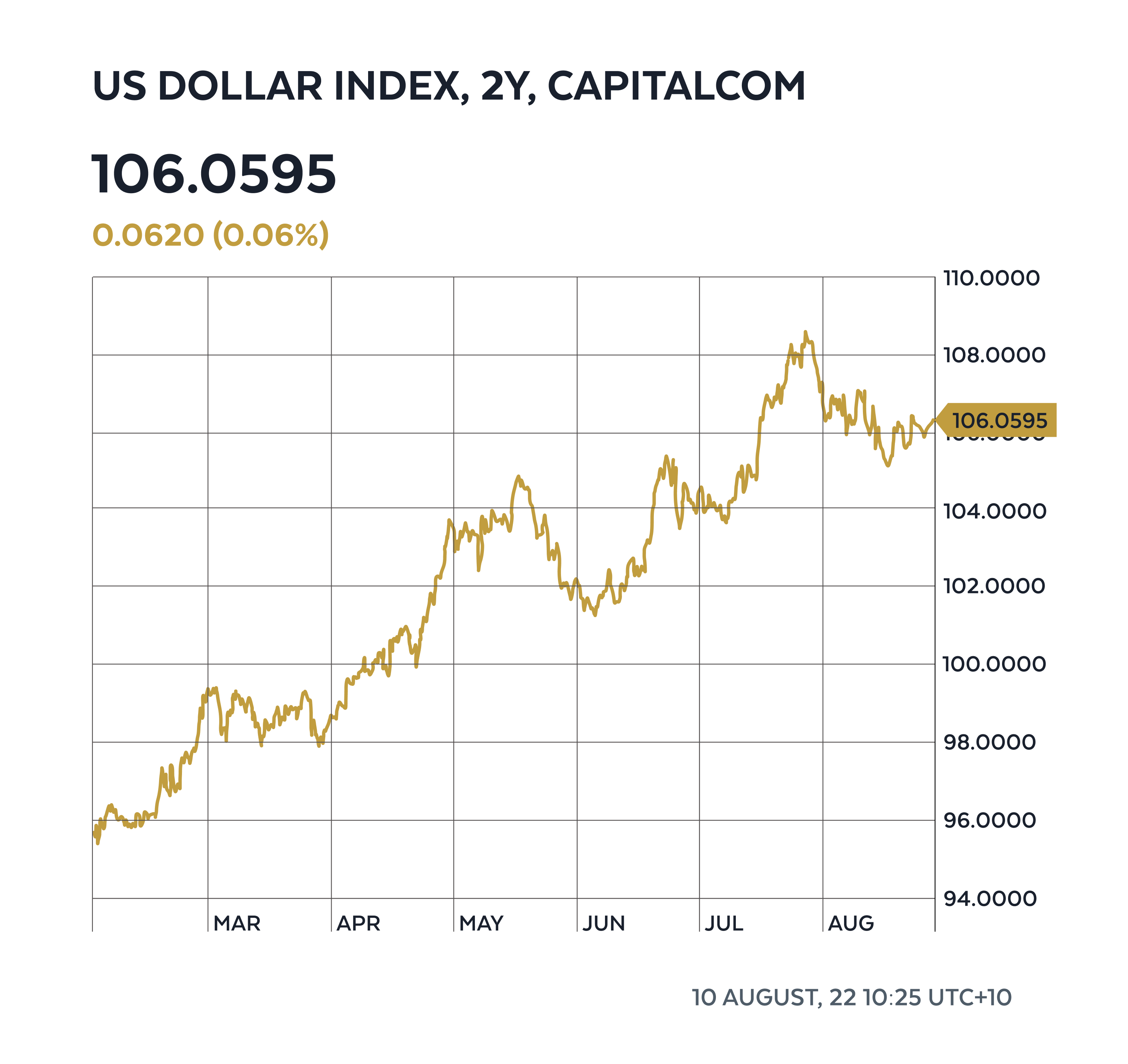
Now, the U.S. dollar index is a very highly traded instrument, so don't pay too much attention to where it is at a specific point. But what I am showing this for is to give you the trend. It's been ongoing. It's been relentless in some respects over the past while. So with that in mind, Kyle, I might go to you on this one, start with you. A strong U.S. dollar obviously has an impact on companies in Australia or companies in Australia with global exposure. Is that a signal or a noise to you?
Kyle Macintyre: I think it's noise. I think currency is so difficult in terms of trying to forecast in terms of where it's going to go. When I think about what drives a company's earnings, we'll use spot currency and we'll use the spot forwards in terms of looking at adjusting for currency there, but in the end, it's noise. However, that doesn't mean that it's not a risk that you need to think about when you're building a portfolio. In the Aussie market, you'd have 28% of the Aussie market with Aussie stocks with offshore earnings, broadly. And so you do need to think about it in terms of your risk exposures and ensure that you know where your portfolio is exposed there. Because what you don't want is a big binary currency bet driving the outcomes of your total portfolio.
So that's how I think about it. It's noise, but it's the noise that you need to understand and control from a portfolio perspective, as opposed to thinking about it from a fundamental stock perspective, because things can change in the next few years.
Hans Lee: Diana, what do you make of this strong run-up in the U.S. dollar? Is it a signal or a noise to you?
Diana Mousina: It's a hard one. I completely agree about currencies being a fickle game, almost, but I think in the short-term, it's a signal. I think the U.S. dollar has a bit more upside to go just because of the concerns around global growth, and potential recession risks, especially the eurozone and the UK being in a recession, most likely. So it seems quite strange the U.S. is really the only one that's actually printed in a technical recession, but the U.S. dollar is extremely strong. So I think it's all these global fears that are still pushing the currency up. But I do think it's probably close to peaking.
Hans Lee: How do you reconcile the difference between an incredibly powerful central bank, a technical recession, I mean, which we were discussing earlier, and then this incredibly strong U.S. dollar?
Diana Mousina: I think it's just because people are worried about more of the global risks and normally when you tend to see global fears and a risk-off environment, the U.S. dollar performs quite well, especially, I mean, it's been extremely strong against the euro.
Hans Lee: Matt, do you have any thoughts on all this?
Matthew Haupt: Yeah. I'm going to go for a massive signal. The U.S. dollar to me, it's like the flight to quality. If the U.S. dollar is rising, we generally have to worry because it signals a lot of things in the environment, in the infrastructure, in collateral markets, and repos. It's like a rush for the U.S. dollar and that's not healthy. So what we use in our portfolio, so when we see the U.S. dollar rising, it triggers off a whole lot of things we've got to look at. So for me, it's a great signal. It's a risk signal. It feeds into financial conditions, globally. A strong U.S. dollar is really bad, globally. So for us, it's a really big signal.
The Charts To Watch
Hans Lee: Let's move straight through to the last part of our show. And this is a bit of a rapid-fire round where we get to show off these guys' talents. We asked each of our experts to bring along a chart that best informs their view of the markets right now.
Diana, I might start with you. Talk to us about what you've brought along. This is market expectations to do with the Australian cash rate.
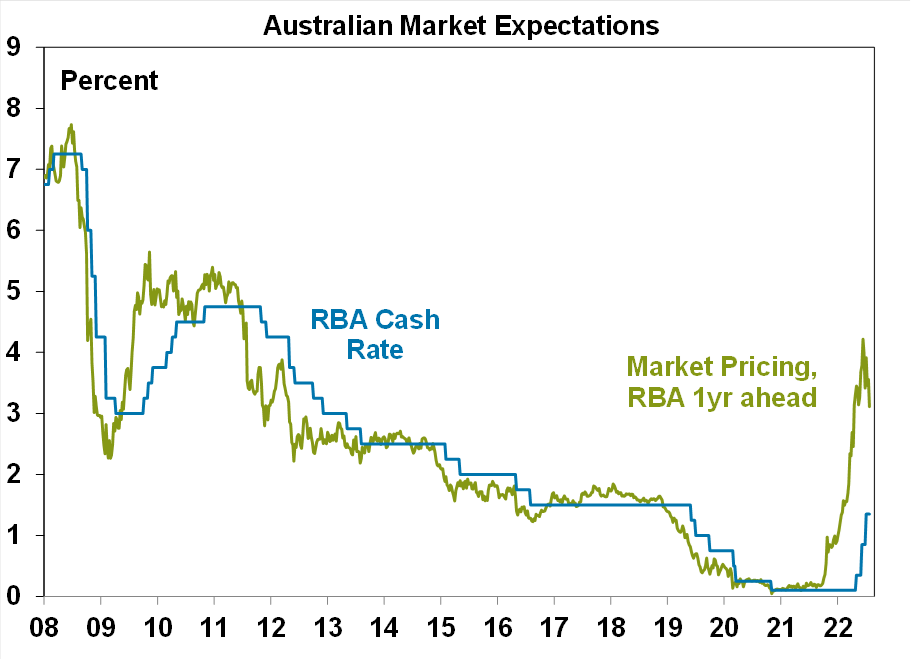
Diana Mousina: Well, what you're looking at there, that green line, you can see that there has been this pivot over the past few weeks about market pricing for the RBA. At one stage, the market was looking for the cash rate to be four and a half, even close to 5% sometime next year and that's come down to about three and a half percent. So I think in the short term, this is positive for share markets and in the U.S., we've seen a pretty similar situation if you want to graph something like this against the Fed.
With this talk about a central bank pivot, I think that there is this real risk that the RBA starts to slow down its pace of tightening. I think that there's a big risk. We'll get a 25 basis point move in September or even a 40 basis point. The market's still pricing in 50.
Hans Lee: Thank you for that. Kyle, we'll move on to yours. I find this interesting. This is Santos versus crude oil. Why specifically this chart?
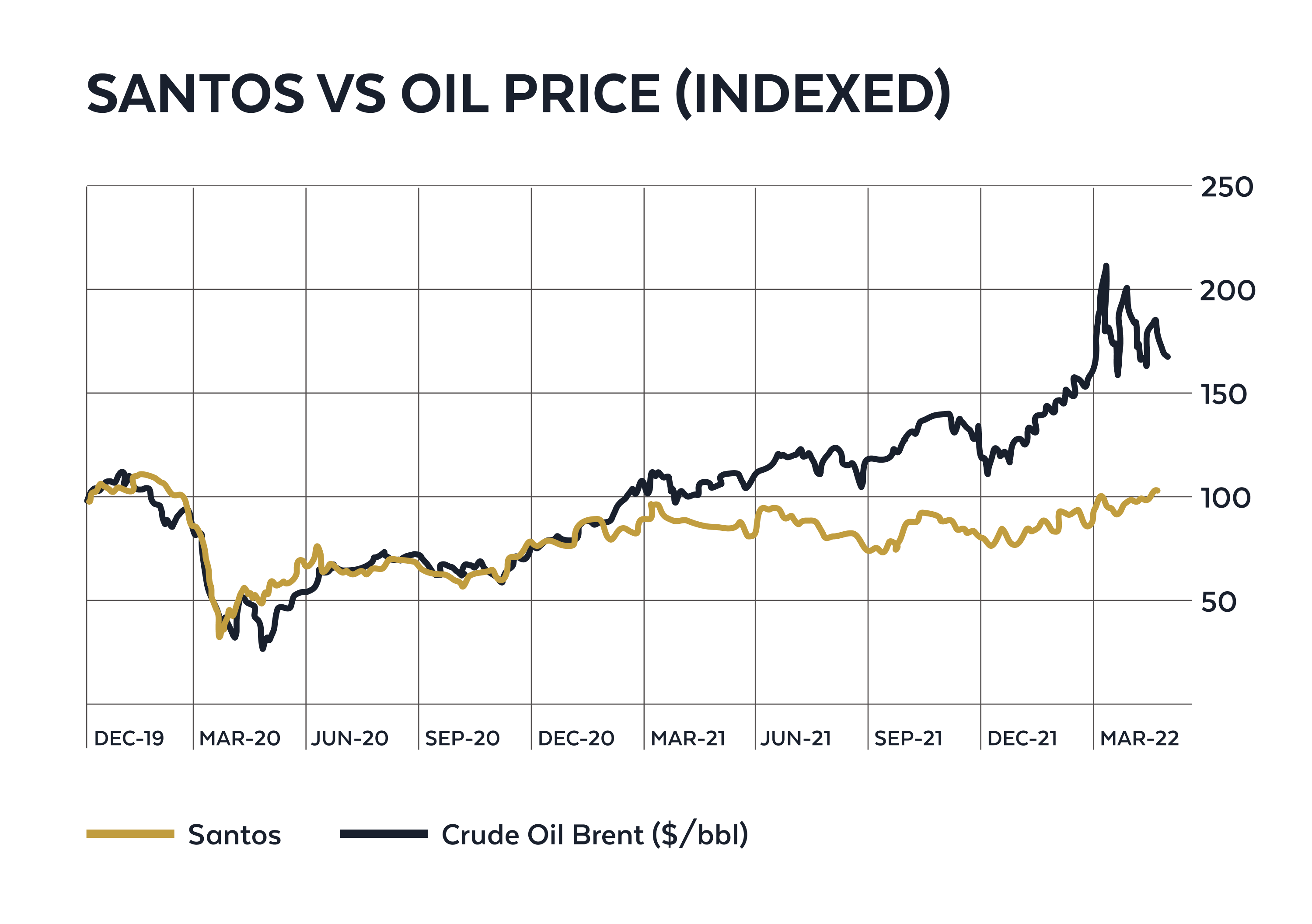
Kyle Macintyre: Well, because everyone's talking about higher oil prices. It's such a big input when you consider inflation, but I wanted people to get a really good feel for how opportunities emerge. And what you can see is a big disconnect between where the Santos share price is trading and where the oil price actually is. That, to me, represents an opportunity because what it tells me is today, the market's pricing in at $60 a barrel of oil price for Santos. And we fundamentally believe, given years of underinvestment in oil supply, that you're going to have higher energy prices for longer. And so for me, despite the fact that oil is driving a lot of these high inflationary outcomes, I also wanted to show that it is creating stock-specific opportunities in the energy space with companies like Santos.
Hans Lee: So the short way of saying that is the energy trade's not over yet.
Kyle Macintyre: I don't believe it's over yet. I think there's a long way to go.
Hans Lee: All right. Matt, I thought your chart was particularly interesting and maybe it's in the sense of when I first looked at it, I wasn't all that familiar with it. So I'm interested if you could please explain the chart you've brought along and why specifically this index.

Matthew Haupt: Yeah. It's Goldman Sachs' financial conditions index. I think it's five factors. Basically, it's a proxy for how tight conditions are or how loose they are. At the start of the year, they were incredibly loose. We went through the tightening phase and you see risk assets under pressure. Now we've gone through this loosening phase where we're back to conditions, back I think in March of this year before we really went into that tightening condition. So I think the central banks are going to be a little bit frustrated.
Conditions are actually eased when they're trying to do the opposite and they're trying to jawbone now because everyone's got interest rate cuts in the forward curve. So I think they're going to have one last press against the market to try and tighten conditions up and then they'll fall apart because everything's really crumbling.
So they can't really go too hard, but they're going to have one more. So this chart is just saying, I think there's room for the central banks to have a push against the market again through hawkish rhetoric.
Hans Lee: Why don't we wrap it up there? Diana Mousina with AMP, thank you very much. Kyle Macintyre, Firetrail Investments and Matt Haupt of Wilson Asset Management. It was the first time having both of you on the show. Please come back and see us.
And thank you for watching. If you like this episode of the show, we will be back together in a month to do this all over again. In the meantime, do consider subscribing to the Livewire Markets YouTube channel and of course, our website. On behalf of all of us, we'll see you next time.
Enjoying Signal or Noise?
Give this wire a like if you've enjoyed the discussion and hit follow to be notified when new episodes are released.
If you're not an existing Livewire subscriber, you can sign up to get free access to investment ideas and strategies from Australia's leading investors.
3 topics
3 stocks mentioned
2 contributors mentioned

